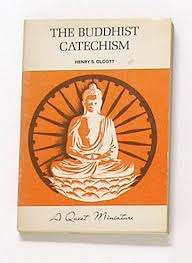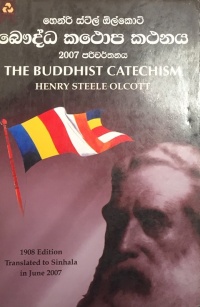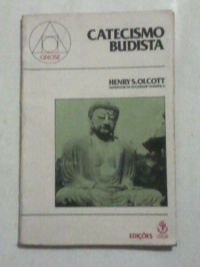The Buddhist Catechism (book)
The Buddhist Catechism presents basic Buddhist teachings compiled from the sacred writings of the southern Buddhists, in the form of questions and answers. It was written by Colonel Henry S. Olcott in 1881 and is still in use in Buddhist schools.
Olcott's objectives in writing
This work was one of Olcott's efforts to help the Buddhists of Ceylon (now Sri Lanka) to establish schools supporting their own culture and traditions.
In many ways a catechism is not a Buddhist way of teaching, which is based more on the interplay of master and student, the introspective exercises of the student, an the use of ritual. But the Catechism is a noteworthy attempt to accomplish two separate tasks. The first is to present in a simple form the basic teachings of Buddhist thought to the faithful, many of whom had never studied the Dharma in a systematic way. The second and more difficult aim was to translate basic Buddhist doctrine into social policies that could serve as guidelines and recommendations for a modern society. One chapter of the Catechism is devoted to the similarities between the Dharma and Western science. This is probably the weekest chapter, and today a good deal more would need to be said on the relationship between traditional Asian philosophies and Western science. In writing the other chapters of the Catechism, Olcott depended on the advice of learned Buddhist scholars in Ceylon, and neither they nor Olcott were modern scientists.
The Buddhist Catechism was widely used... The success of the catechism came as a surprise to Olcott himself ... He saw the need for an improved, widely-accepted teaching tool, and he created it.[1]
Fritz Kunz account of children's edition
The catechism was simplified by C. W. Leadbeater to create a children's edition, according to Fritz Kunz's account from 1905:
Sometime ago when in Ceylon I sent you two little square Sinhalese pamphlets in coloured paper backs, but I forgot when writing to explain what they were. Please preserve them carefully, for they are curiosities, as representing the very first book which [Leadbeater] wrote in this incarnation. They are the two parts of an introductory catechism of Buddhism, which he wrote for the children to learn before they were old enough to understand the more difficult catechism which Colonel Olcott had prepared. He found that the answers in the latter are much too long and complicated for little children to remember, so he wrote this, and had it approved for use in Buddhist schools by the Chief Abbot Sumangala. It is much the most popular of his works; so far 100,000 copies have been sold, and it is still in use all over the island of Ceylon. It has also been translated into Japanese for the use of the children in that country.[2]
Translator's note in the children's edition
This note appeared in the 1901 edition. C. Jinarajadasa translated Leadbeater's children's edition into Sinhalese:
Note by the Translator: THIS work is a translation of a small Sinhalese Catechism of Buddhism in two parts, called Bauddh Çiçubodhaya, which was compiled by Mr C. W. Leadbeater in 1889, when he was working in connection with the Buddhist Theosophical Society. Of the first part of it there have been published 60,000 copies (21st edition), and of the second part 35,000 copies (18th edition). It was meant to be introductory to the more comprehensive Buddhist Catechism (now in its 43rd edition) of the late Colonel H.S. Olcott, President-Founder of the Theosophical Society. It is with the same object of supplying an introductory work, in English, to Colonel Olcott’s Catechism that I have undertaken this translation. The original Sinhalese edition of Bauddha Çiçubodhaya was carefully revised in both parts by the Venerable High Priest Hikkaduve Sumangala, and the second part by H. Devamitta, Anunâyaka Thero, also. It has not been thought desirable to given an absolutely literal translation of all phases, the idioms of the two languages being so different. Some phrases too have here and there been added, to make a question or answer more lucid, and two additional questions, 19a and 19b of part II, and some notes also, have been added. Here and there a fuller translation of a phrase has been substituted directly from Pãli, instead of from Sinhalese. I have found it impossible to observe uniformity in the language in which the names or the technical terms have been given, simply because in Ceylon some are familiar only in Pãli, and others only in Sanskrit; to attempt uniformity would have been to introduce many unfamiliar forms. In conclusion I must express my deepest obligations to my friend and teacher in Pãli, Mahagoda Ñãnissara Thero, Principal of the Vidyodaya College, for the help he has given me throughout in the preparation of this translation. His interest in the work and the constant explanations of Pãli terms and ideas have alone made it possible for me to undertake this work.
Publication history
On April 22, 1881, Col. Olcott sailed for Ceylon (Sri Lanka) mainly for the purpose of raising an Educational Fund to start schools. During the voyage he compiled the catechism, which was finished on May 5. The book was published on July 24 both in English and Sinhalese, with the financial support of Mrs. Ilangakoon of Mâtara. The two first editions were rapidly sold and before the end of August a third one became necessary.
Some small corrections by High Priest Sumangalawere introduced in the 42nd edition of 1907, arranged before his death by Col. Olcott. Annie Besant wrote the Preface to that edition.
By 1889, it had been translated into 15 languages, mostly those of Asia, and by 1977 had been translated into twenty languages and 45 printings. Languages include French, German, Swedish, Russian, Bulgarian, Spanish, Burmese, and Tamil. The book is still in use in Sri Lanka.
Availability online
- 1st edition - 1881 - at Blavatsky Archives.
- 3rd edition - 1887 - at Google Books.
- 42nd edition - 1907 - at Sacred Texts.
- 42nd edition - 1908 - at Internet Archive.
- 42nd edition - 1915 - at Gutenberg.org.
- 44th edition - 1915 - at Hathitrust.


